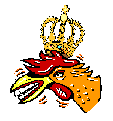
.gif)
[Home] [What's New] [About the K&R] [Links] [Site Map]
Hunting Pictures
[Dove]
[Waterfowl]
[Grouse]
[Woodcock]
[Other]
Wood Ducks
[Overview]
[1997]
[1998]
[1999]
[2000]
[2001]
[2002]
[2003]
[2004]
[2005]
[2006]
[2007]
[2008]
[2009]
Mallards
[Overview]
[1999-2000]
[2000-2001]
[2001-2002]
[2002-2003]
[2003-2004]
[2004-2005]
[2005-2006]
[2006-2007]
[2007-2008]
[2008-2009]
[2009-2010]
Geese
[Overview]
[1999-2000]
[2001-2002]
[2002-2003]
[2003-2004]
Other
Waterfowl
[Overview]
[Bufflehead]
[Gadwall]
[Teal]
[Ringneck]
[Merganser]
[Shoveler]
Waterfowl Hunting Overview
|
The King & Rooster started waterfowl hunting in the fall of 1997. It quickly became apparent when we started that duck and goose hunting was going to be a lot different from upland game bird hunting. A successful hunt would require detailed planning beforehand that included scouting/reconning the area, tracking the weather patterns both local and northward, and the logistical concern of getting ourselves, maybe the canoe, waders, blind building materials, etc., to the hunting site. Additionally, a significant amount of homework would have to be done to produce successful waterfowl hunts. We would have to learn how to identify different species and genders of ducks, practice calling, learn how to use decoys properly, and figure out how to camouflage ourselves and equipment. Since that first year, we have gotten better in each of these areas but still need to improve to reach the proficiency level we want.
The tactics of waterfowl hunting here in WV are, in a lot of cases, determined by the topography of the waterway. There are very few areas in the state that offer the traditional upper Midwest version of waterfowl hunting. Very few (as in none) 10,000 acre flooded grassland areas are within our hunting radius. What we do have, however, are some nice rivers that are major highways on the flyways and some nice lakes/ponds/swamps that make attractive rest-stops. This topography has pushed us to a more aggressive waterfowl hunting style than only blind building and decoy laying. Although we have engaged in static blind waterfowl hunting with some success, most of the waterfowl we still put in the game freezer come from using a canoe or waders to get ourselves to the ducks/geese while they are on the water. The majority of ducks we see in a season are wood ducks. They are a great fit for the flooded timber areas around lakes/ponds and small waterways throughout the state. They tend to set up and stay local for quite a while. Mallards, of course, also play a major part in waterfowl populations in the state. They love to follow the major rivers south when it gets chilly up north and at the right times you can find a bunch of them if you know where to look. The geese we see are Canadas. They are pretty much everywhere off-limits to hunting in WV but seem to be scarcer where the steel can fly. Other waterfowl that are seen in some numbers are teal (green and blue-wing), blacks, buffleheads, goldeneyes, northern shovelers, ring-neck ducks, mergansers, and gadwalls. The following links will take you to pages that show the waterfowl we have taken through the years by species. [Wood Ducks] [Mallards] [Geese] [Other Waterfowl]
|
[Home] [What's New] [About the K&R] [Links] [Site Map]
King and Rooster © 2004 All Rights Reserved